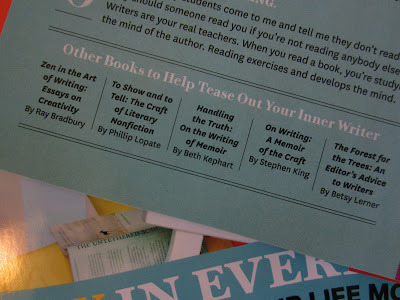Beth Kephart's Blog, page 127
June 19, 2013
The faces of New Orleans
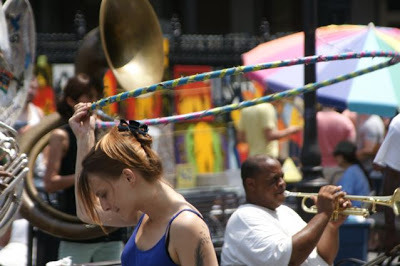
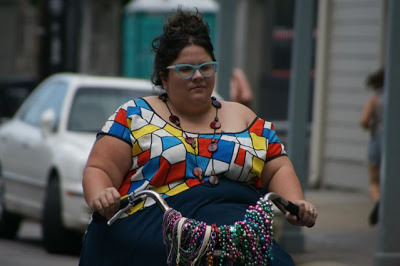
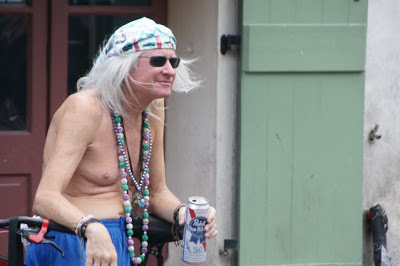
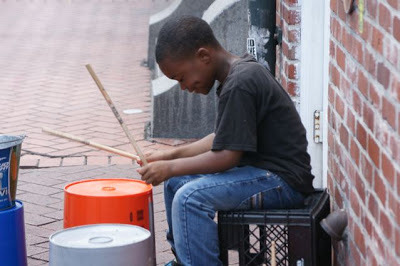
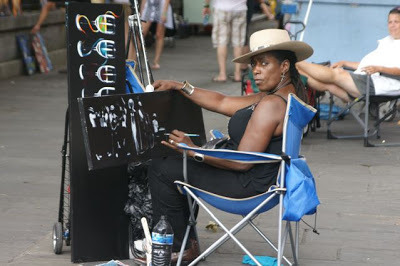
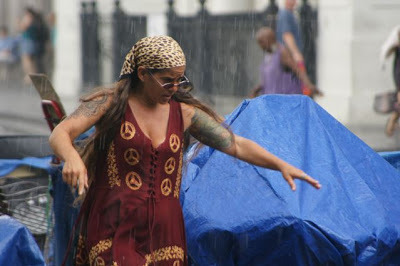
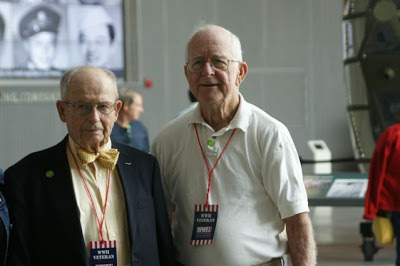
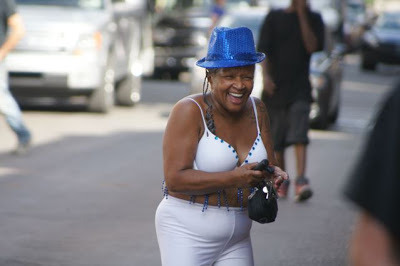
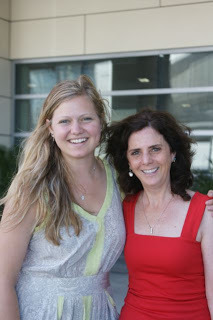
Back at my desk, with my actual photos in hand, I share some of the faces of New Orleans, the city where I've spent the last few days. Most of the faces are self-explanatory. The two World War II vets were found at the massive and moving World War II museum, in the city's warehouse district. The final picture was taken by my husband in the final hour—Katie Goldrath, my former student, and me, saying goodbye (but hopefully not for long).




Published on June 19, 2013 03:35
June 17, 2013
New Orleans Color
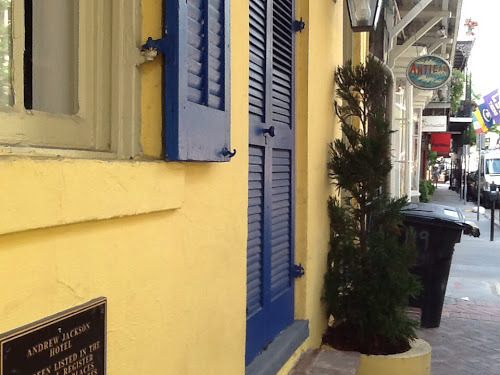
It is, perhaps, the size and depth of this city that has surprised me most of all—the magnitude of the buildings in the warehouse district, the multi-block World War II museum, the innumerable voodoo institutions, the musicians finding the sweet shade within the streets, the artists rimming Jackson Square, the great expanse of Tulane University, the irreducible southern homes along St. Charles.
My real photos will be shared tomorrow. For now, violet and ochre, late afternoon.
 Posted with Blogsy
Posted with Blogsy



Published on June 17, 2013 16:41
On Royal Street, in N'Awlins
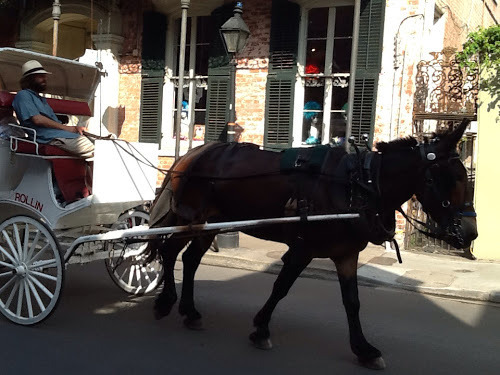
Time works differently in New Orleans. You are managed by the heat and the sun. Rise early and find the thin shadows. Walk St. Charles Avenue toward Tulane until you can't anymore, and a cable car saves you. Go out again, five-ish, showered, fresh, and find the shade; you'll be drenched before you do. Take a photo of a passing mule with the iPad because it's what you've got.
At night, the tourist crowds rope around the vampire guides, the ghost guides, the haunted houses guides. The high-steppers carry their neon green daiquiri glasses down Bourbon. On Frenchmen Street, the musicians pack in the crowds at the Apple Barrel, The Three Muses, The Blue Nile, and for the price of a drink, and maybe a CD, you are in, too.
In the morning, rise early. Tell yourself you can beat the sun.
 Posted with Blogsy
Posted with Blogsy



Published on June 17, 2013 05:37
June 16, 2013
N'Awlins
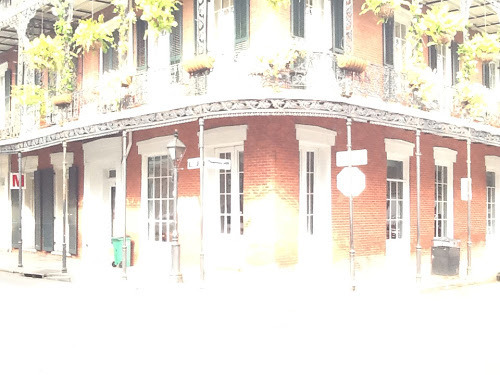
I am, as my friends know, a Philadelphian, through and through. Still, it becomes increasingly important, as I age, to see more of this country that I also claim as my own—cities like Asheville and Staunton, Lexington and Miami, and, this weekend, New Orleans.
There she is, Bourbon Street, just ahead of a storm. Tanya and Dorise, the violinist and guitarist, are playing on a corner just behind me. Gifts for my husband and father are in a store a few blocks ahead (they will be wrapped, immaculately, by a Frenchman with a wax stamp). The morning (spent wandering up St. Charles Avenue and through the Tulane University campus) seems like a hot-sauna year ago. The evening (a little jazz) is still being planned.
I have Edna O'Brien and Colum McCann on this iPad. I've read the New York Times and watched those beloved NYT videos during rain storms.
I have no work in the room.
There is not a lot I love about getting older. But choosing to act now, to forestall regret later, is a bright benefit.
 Posted with Blogsy
Posted with Blogsy



Published on June 16, 2013 16:07
June 14, 2013
holding the actual O magazine summer reading issue in my own two hands for the first time
Published on June 14, 2013 09:39
Grace Before Dying/Lori Waselchuck: Reflections
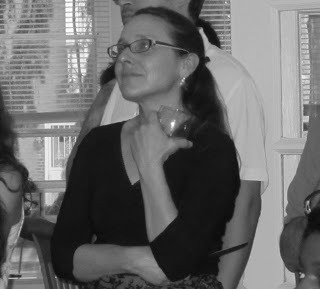
By tomorrow afternoon I'll be walking the streets of New Orleans, a city I've long yearned to see. My dear friend Ruta Sepetys set her second novel, Out of the Easy, there. Katie, my student, has been living there this past year—absorbing the culture, bringing her compassionate heart to triage work, and lending her name to a leading character in the novel I finished first-drafting last week. And for a few important years, New Orleans was home to my new friend Lori Waselchuk, the award-winning documentary photographer and fellow Pew Fellow of whom I have written here and (in conjunction with the launch of Anna Badkhen's The World is a Carpet) here.
Today I dedicate this blog to Lori's deeply moving book, Grace Before Dying, a photographic essay inspired by the three years Lori spent documenting the hospice program at the Louisiana State Penitentiary. Lori was invited to do this work by the magazine Imagine Louisiana. She could not, after the assignment was done, imagine walking away. For within the walls of what was once the most notorious prison system in the world—cruel, overcrowded, filthy, murderous—Lori had met men caring for men in their final months. She had met double murderers with a gentle touch, coffin builders with loving hands, laborers waking early to sit in vigilance for their dying best friends, prisoners who had become expert quilters. The hospice program at this prison, also known as Angola, had gentled, and lifted, spirits. It had eased men—some of them locked up for life on drug possession charges—out of bitterness and toward love.
Lori documents the day to day in the hospice program with black and white photographs that are wide angled and intimate and exceptionally personal and true. She shows us the needle in the hands of the quilter, the name on the foot of a sock, a man's last moments, a procession of mourners. She shows us Lloyd Bone, "incarcerated at Angola in 1971 for murder" as he "guides the horse-drawn hearse carrying the body of George Alexander to Point Lookout II, Angola's cemetery" and the "procession of hospice volunteers and friends" as they "walk and sing behind the hearse."
I had looked through Lori's photographs the very day she gave me this book. Today I sat and read her moving introduction, Lawrence N. Powell's essay on the prison's history, and every single caption. I read, too, Lori's acknowledgments in the back, where she writes, in part, "My words of appreciation come up short, so I will express my gratitude through living a life and producing work that emulates the humanity they show for each other."
I haven't known Lori Waselchuk long. But I've seen her throw a party for a friend, lift a friend's child to her hips, talk about the neighbors she loves in West Philadelphia. I've heard Lori talk, and I've seen Lori carry the good flame forward.




Published on June 14, 2013 04:03
June 12, 2013
Someone/Alice McDermott: Reflections on a Perfect Novel
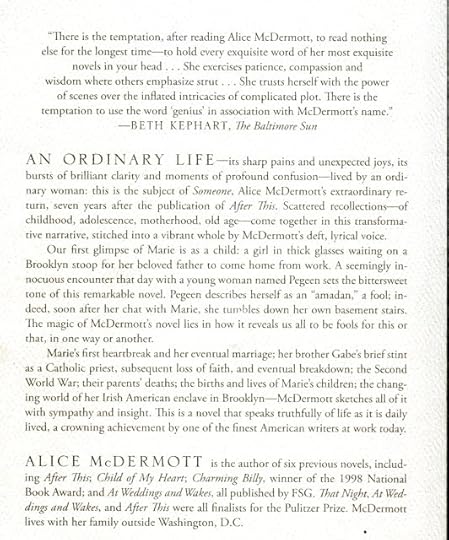
I have had this galley of this most important book for several days. I hadn't read it for this simple reason: reading it once was the surest way I knew of never again being able to read it for the first time. This is an Alice McDermott book. This is an occasion.
Yesterday a friend called, asked what I was doing; I said "reading." She asked if there was really anything new that I could learn from books, having read and written about "thousands" in my life (I've no idea how many books I've actually read; I'm quoting now from a conversation). Oh, I said (a rushing oh). I learn every time. Good or bad, I read, I learn.
Reading Alice McDermott, I learn about time. I learn about how an entire life can be surged forward and reclined against. I learn about the power of those two or three knowing nods to the future, about the devastation of a quiet recoil, about the intimacy between a reader and the page when a character privately reassess the past. I learn about economy and also about largesse, but mostly, mostly, every time I read Alice McDermott, I am reminded of the great complexity of "simple lives," of the small heroics that make us human, of the heartaches we cannot defend against. I am reminded that there are writers among us who know. Not a single gimmick in an Alice McDermott book. Not a single nod to the commercial antics of our time. Walk down her Brooklyn street. Meet Marie. Watch her tumble toward love, grasp toward knowing, learn about comfort, give it, grow old. When you do this thing you will have opened your heart to the nameless strangers among us.
You are expecting proof. It's on every single page. No sentence anything by perfect. No scene anything but sceneless. No detail superfluous.
Here, for example, on an early page, we meet the blind umpire on Marie's Brooklyn street. An older Marie is remembering a younger Marie here, and somehow McDermott gives us the sense of both perspectives at once. But also here is not just a singularly interesting character and a quietly compelling scene. Here, in this paragraph, are the seeds for the devastation yet to come. Nothing superfluous, as I said.
Bill Corrigan wore a business suit and polished shoes, and although there was a glitch in the skin around his eyes, a scarred shine in the satiny folds of his eyelids, although he was brought to the kitchen chair every afternoon when the weather was fine by his mother, whose arm he held the way a bride holds the arm of a groom, it was to him that the boys in the street appealed whenever a dropped ball of an untimely tag sent both teams, howling and cawing, to his side of the street. They were there now: shouting into each other's face, throwing their caps on the ground, and begging Bill Corrigan to make the call. He raised one of his big, pale hands, and suddenly half the boys spun around, and the other half cheered. Walter Hartnett rocked backward in despair, raising his good foot in the air.
Very few people know what writing is in the way that Alice McDermott knows what writing is. But every reader should know her work.




Published on June 12, 2013 07:48
Headed to NYC on June 23rd, with Dr. Radway and Small Damages
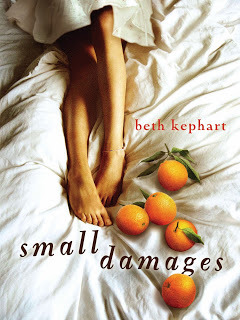
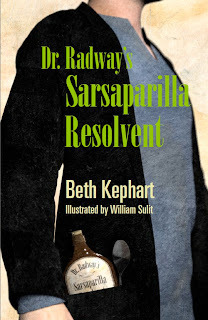
Let's be honest: My dear Dr. Radway has had a bit of a rocky distribution start, leaving this writer on the wrong side of brokenhearted. All of which has made me even more grateful for the beautiful reviews, for the uplift of friendship, and for those who have believed in this story. I wrote this book over a period of five years. William, its protagonist, is as real and dear to me as any of my neighbors. And his Philadelphia is my Philadelphia, a city I will always love.
One of those true believers is Peter Glassman, the Man Behind Books of Wonder, that rousing New York City bookstore that hosts the very best in children's and YA. I'll be there, on the afternoon of June 23rd, with both Dr. Radway and Small Damages, and I'd love to say hello, if you happen to be passing by. Come meet us from 1 through 3.
I'll be joined by this fantastic group of writers:
LISA JAHN-CLOUGH Nothing But Blu (HMH)
LEILA HOWLAND Nantucket Blue (Disney)
ALLEN ZADOFF Boy Nobody (Little Brown)
JAQUELINE GREEN Truth or Dare (Little Brown)




Published on June 12, 2013 05:00
June 11, 2013
Perfect Red/Jennie Nash: Reflections

Early this year, I received a gift from my friend Jennie Nash, a writer and teacher whose first novel, The Only True Genius in the Family, I wrote of here . This time, the gift was wrapped in a red bow and bookmarked with a faux library card. The book was called Perfect Red, and it was, I knew, from many emails with my friend, a book that Jennie had loved making. That loving shows in every detail.
Perfect Red has since been sitting here waiting for the perfect reading hours. I found those yesterday, in the midst of an enormous storm. Client work was done and the rain was falling in white sheets and lying down beneath a blanket with a bright book in my hands was the cure for both the weather and an extremely moody back.
How easy it was to fall into this tale about an ambitious McCarthy-era writer among the sharks of New York City publishing. Lucy Lawrence, at work as a secretary in a leading publishing house, has ideas for a novel about a passion-inducing lipstick called Perfect Red. She also learns, early on, how hard it is to actually write a book, and soon she is giving her idea to a famous novelist who is stuck and in need of an imaginative re-boot. It all becomes quickly (shall we say) complicated as the novelist turns out to be an incompetent bully, as Lucy realizes that she can indeed write that novel, and as the mystery at the heart of this lipstick—Perfect Red—has some people thinking the whole thing is a communist metaphor. Who will get to write this book? How will Lucy live the lessons she learns about the difference between lust and love? And who will protect Lucy when she takes the stand before the House Un-American Activities Committee?
Perfect Red is fast-paced and fun, full of sly vignettes from the publishing world, including walk-ons from the New Yorker crowd. It's coy, it's clever, it's a flowering romance, and, Jennie, I'm so glad I saved it until yesterday—its splash of red against the white wall of weather.




Published on June 11, 2013 03:55
June 10, 2013
Still Writing/Dani Shapiro: Reflections

When I set out to write Handling the Truth, I burrowed in with the books that I have always loved—built a minor cathedral with printed paper, stiff spines, glue. Memoirs, specifically. Books that had taught me something or reinforced something, that exemplified, were exemplary.
One of those loved books was Dani Shapiro's Devotion, a memoir that, as I wrote here years ago, felt pure to me, spun from a sacred, silent place. Dani's book became one of the nearly 100 books I celebrate in the pages of Handling. Her prose offering an essential lesson in quiet generosity.
When I learned that Dani was publishing a book called Still Writing, I knew that something significant was about to make its way into the hands of writers all around the world. I trusted that she would write with both clarity and beauty, that she would open her heart, that she would not hide, that she would elevate writing advice to profoundly intelligent writing insight. All this she does, seamlessly, in a book that is destined to be a classic.
Reading Still Writing is like sitting with a best friend who gets you—really gets you. Someone in whom you might confide, someone with whom you might look out upon a garden space, silently. Yes, you hear yourself saying, I have been there. Yes, I've felt lost, too, uncertain, crushed, but also moved, privileged, calmed, finally certain in the midst of making a book. Wisdom, honesty, and reach abide in Still Writing. But so does companionship.
As one who teaches as well, who writes about words, who sometimes writes her own stories, I felt so aligned with Dani as I read that I'm afraid I sometimes spoke out loud while reading. I loved many passages. Let me share just one. It's the sort of advice I've tried to share with many writers throughout the years. But Dani says it better:
There's nothing wrong with ambition. We all want to win Guggenheims and live and write in the south of France, or some version thereof—don't we? But this can't be the goal. If we are thinking of our work as a ticket to a life of literary glamour, we really ought to consider doing something else.
Still Writing will be published in October by Grove Atlantic.




Published on June 10, 2013 12:15

